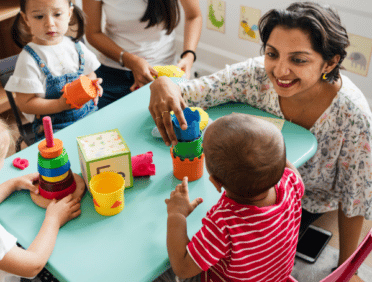Filter by
Working Together to Safeguard Children’s Guidance
The future of the population is contingent upon the well-being of the younger generation, necessitating a collaborative effort from all sectors of society to safeguard them from harm. Communities, schools, healthcare providers, and government agencies, in addition to individual families, are all involved in the priority of ensuring the safety and welfare of children.
Working collaboratively, the United Kingdom can establish a secure environment in which children can flourish and realise their maximum potential. The safety and well-being of the nation’s children are the responsibility of all individuals, and by remaining vigilant and informed, we can make a substantial impact on their lives.
The Role of Education
Schools are essential in the protection of students. Educators and school personnel are frequently the first to identify indicators of neglect or abuse. Schools can establish a secure environment for children by enforcing rigorous safeguarding policies. Teachers must receive training on how to identify and address concerns. Also, educational institutions must strive to cultivate an environment in which students are at ease reporting any concerns they may have.
Community Involvement
The foundation of child protection initiatives is the community. Neighbours, acquaintances, and extended family members can provide support and serve as additional observers and listeners. Community programs that aim to inform people about the signs of child abuse and neglect can significantly improve local safeguarding efforts.
Initiatives such as community centres and neighbourhood watch groups offer valuable resources and support networks to families in need.
Health Services and Safeguarding
Health care providers, such as nurses, physicians, and social workers, are necessary for the protection of minors. This can assist in the early identification of any concerns through routine health check-ups and interactions with children and their families. All employees of health services should be trained in the identification of indicators of abuse and be aware of the appropriate channels for reporting their concerns.
Health services and other organisations must collaborate across multiple agencies to establish a comprehensive safeguarding framework.
Government and Legislation
Government policies and legislation serve as the bedrock of child safeguarding in the United Kingdom. These laws, including the Children Act 1989 and the Children Act 2004, establish the legal framework for the protection and promotion of the welfare of children. In order to guarantee that safeguarding practices continue to be effective and to address emergent threats, the government is required to conduct ongoing reviews and updates of these laws.
Another critical aspect of government responsibility is the provision of funding for child protection services and training programmes.
Digital Safety
The protection of minors online has become a significant concern in a world that is becoming more digital. Schools, communities, and parents must collaborate to educate children on internet safety. This encompasses comprehending the hazards linked to online games, social media, and other digital platforms.
Parental controls and monitoring software are effective tools for overseeing children’s online activities; however, it is equally crucial to engage in open dialogue regarding secure internet usage.
Reporting and Responding to Concerns
The ability to disclose and respond to safeguarding concerns is essential for all individuals. Clear procedures must be established for the reporting of suspicions of abuse or neglect. In order to guarantee that volunteers and employees comprehend their obligations, organisations ought to arrange training sessions.
Prompt and appropriate responses to reports can be implemented to guarantee that children receive the requisite protection and prevent additional harm.
Support for Families
A proactive approach to the protection of children is to provide assistance to families. Access to resources such as financial assistance, mental health services, and parenting classes can mitigate the pressures that may result in neglect or abuse. Community centres and local charities frequently provide invaluable support services, thereby establishing a network of support for families in difficult circumstances.
Frequently Asked Questions (FAQs)
The “Working Together to Safeguard Children” guidance is a comprehensive framework for the protection and advancement of the welfare of children in the United Kingdom. The Department for Education has issued a directive that delineates the procedures for collaboration between individuals and organisations in order to safeguard children from damage. This statutory guidance is applicable to all individuals who labour with children, thereby guaranteeing their safety and well-being.
The legislative requirements and expectations for individual services to protect and advance the welfare of children are delineated in this guidance. It also offers an unambiguous framework for Local Safeguarding Children Boards (LSCBs) to evaluate the efficacy of local services. Safeguarding is the responsibility of all individuals, and its effectiveness is contingent upon a coordinated and expeditious response. This principle is the foundation of this guidance.
The document addresses the processes and principles for inter-agency working, information sharing, and the responsibilities of various organisations in identifying and responding to concerns about children’s safety. It underscores the significance of comprehending the unique requirements of each child and family and responding accordingly.
Compliance with this guidance guarantees a uniform and comprehensive safeguarding strategy in all sectors.
All professionals and organisations in the United Kingdom that work with children and families are required to stick to the “Working Together to Safeguard Children” guidance. This includes schools, health services, police, local authorities, and voluntary organisations. These entities guarantee that they are fulfilling their legal obligations to protect minors by adhering to this guidance.
Local authorities are obligated to collaborate with other agencies to guarantee the effectiveness of child protection services. This guidance is also mandated for healthcare professionals, such as general practitioners, nurses, and mental health practitioners, in order to identify and address child welfare concerns.
From early childhood settings to universities, educational institutions are required to establish safeguarding policies that are consistent with this statutory guidance.
Also subject to this guidance are faith groups and community and voluntary organisations. They must guarantee that their employees and volunteers are provided with the necessary training to identify indicators of abuse and to respond to any concerns. Ultimately, the objective is to establish a network of volunteers and professionals who are well-informed and committed to the effective protection of children.
The primary objectives of the “Working Together to Safeguard Children” guidance are to guarantee the safety and welfare of all children. These principles include the necessity of multi-agency collaboration, the significance of early assistance, and a child-centred approach. Professionals can offer the most effective protection for children by sticking to these principles.
The welfare of the child comes first in all decisions and actions when using a child-centered approach. It is recommended that professionals attend to children and take their perspectives into account when making decisions. Early assistance entails the identification and provision of assistance to children and families at the initial indication of a problem, thereby preventing the escalation of the situation.
The protection of minors necessitates the cooperation of multiple agencies. This entails the collaboration of various organisations, the exchange of information, and the coordination of their endeavours to safeguard minors.
The guidance underscores the necessity of effective communication and collaboration among all agencies that are engaged in a child’s life, thereby guaranteeing a comprehensive safeguarding strategy.
“Working Together to Safeguard Children” includes explicit definitions of child abuse and neglect that are crucial for the identification and resolution of these concerns. Emotional abuse, neglect, sexual abuse, and physical abuse are all forms of child abuse. Each category has distinct indicators and prospective effects on the well-being of a child.
Abuse of a child’s body can take many forms, including beating, shaking, or burning, and it is considered to be a form of physical abuse.
Consistent emotional maltreatment that has an effect on the emotional development of a child is an example of emotional abuse. Other examples include bullying and frequent criticism.
Sexual abuse occurs when a kid is coerced or enticed into engaging in sexual acts, regardless of whether or not the youngster is aware of what is taking place under the circumstances.
The consistent inability to address the fundamental physical and emotional requirements of a child is what we mean when we talk about neglect. This can have a significant impact on the child’s health and development. This includes failing to provide sufficient food, shelter, clothing, or supervision for the individual.
When professionals are aware of these concepts, they are better able to recognise certain indications of child abuse and take the proper measures to protect children.
The guidance titled “Working Together to Safeguard Children” assigns particular tasks and obligations to a number of different organisations in the process of protecting children. To guarantee the well-being and safety of children, it is necessary for local authorities, health services, educational providers, and law enforcement organisations to work together. Within the framework of the multi-agency approach to child protection, each agency performs an important role.
The responsibility of coordinating child protection services and ensuring effective collaboration amongst law enforcement agencies falls on the shoulders of local authorities. Conducting assessments, offering support, and ensuring that child protection strategies are in place are all responsibilities that fall under their purview.
The identification of indicators of abuse, the provision of medical care, and the referral of cases to the relevant authorities are all responsibilities that fall under the purview of health services, which include general practitioners, nurses, and hospitals.
The implementation of safeguarding policies, the training of staff, and the creation of secure surroundings for children are all requirements for educational institutions. The first places to discover changes in a child’s behaviour or well-being are frequently the schools, and it is their responsibility to address these problems.
As part of their efforts to protect children, law enforcement agencies conduct investigations into claims of abuse, try to prevent harm, and interact with other agencies. When it comes to effective protection, the coordinated activities of each agency are absolutely necessary.
Safeguard Children” guidance. It offers individuals learning opportunities that are easily accessible and adaptable, allowing them to acquire vital knowledge and skills. Online courses can be adapted to a wide variety of professional responsibilities, ensuring that all participants obtain information that is both pertinent and applicable to their particular circumstances.
The important parts of the advice are covered in these training programmes, such as the ability to recognise symptoms of abuse, awareness of the legal framework, and the ability to know how to initiate referrals. They also emphasize the importance of excellent coordination and communication between various agencies.
When professionals successfully complete these courses, they are better equipped to fulfil the safeguarding tasks that are assigned to them.
The ability to participate in online training enables constant professional development. It guarantees that professionals are up to date on the most recent practices, regulatory changes, and guideline updates throughout the entire process.
Providing children with regular training helps to maintain a high degree of safeguarding practice, which in turn contributes to the overall safety and well-being of children.”
As a means of providing adequate protection for children, professionals must be diligent in recognising the signs and symptoms of child abuse. Unknown injuries, bruising, burns, or fractures are all indications that the victim has been subjected to physical abuse. Fear of going home, flinching when approached, or wearing long sleeves to hide injuries are all examples of behaviours that could be considered behavioural markers.
Excessive withdrawal, low self-esteem, or dramatic behaviour changes are all possible indicators of emotional abuse. There is a possibility that children will display developmental delays, have difficulty building relationships, or exhibit symptoms of anxiety and despair.
A person may exhibit indicators of sexual abuse if they are aware of or interested in sexual actions that are inappropriate for their age, if they are experiencing physical discomfort, or if they suddenly change their personality or behaviour.
Poor hygiene, hunger, frequent absences from school, and a lack of clothes that are appropriate for the weather conditions are all indicators that it is possible to identify neglect. It is also possible for neglected youngsters to exhibit signs of exhaustion, hunger, or theft of food.
When professionals are able to recognise these signs and symptoms, they are able to take fast and appropriate action to protect children.
Prompt and appropriate action is absolutely necessary in the event that a professional has a suspicion that a child is being mistreated or neglected. Instead of making promises or asking leading questions, the first thing that should be done is to listen to the youngster and provide reassurance.
It is essential to be sure that any disclosures are accurately recorded and that the issue is communicated to the individual who is designated as the safeguarding lead within their organisation.
The professional ought to adhere to the safeguarding policy of their organisation, which will provide an outline of the procedure for reporting concerns. Typically, this entails submitting a referral to the children’s social care department, providing specific information regarding the concerns, and presenting any proof that may be relevant. It is important that the referral be made without delay, since prompt action is necessary to ensure the child’s safety.
Maintaining confidentiality and only disclosing information to those who have a legitimate need to know is another responsibility that professionals should take on. It is essential to continue providing the youngster with assistance and to create an atmosphere that is secure and trustworthy.
To meet their safeguarding responsibilities and guarantee that they are operating in the child’s best interest, professionals can ensure that they are taking these measures.
A number of essential procedures are required in order to make a referral to children’s social care in accordance with the “Working Together to Safeguard Children” guidance. Initially, it is important for experts to collect as much information as they can about the child and the issues that they are concerned about. This comprises information concerning the identity of the child, the history of the family, and the nature of the suspected abuse or neglect of the child by the family.
When making the referral, the professional ought to get in touch with the children’s social care service in their immediate vicinity. In most cases, this can be accomplished through the use of a specialised referral form or by making a phone call. A clear and accurate presentation of all pertinent facts, including any evidence or observations that support the issue, is of utmost importance.
Following the completion of the referral, the children’s social care department will carry out an initial assessment in order to ascertain the level of risk and the appropriate response. As part of their inquiry, they could involve other organisations, such as the police or the health services.
It is important for the professional who referred the kid to be active throughout the entire process, continuing to offer support to the child and offering more information if it is required.
During the process of protecting children, the guidance titled “Working Together to Safeguard Children” places an emphasis on the significance of collaboration across many agencies. It includes a description of the manner in which various organisations ought to collaborate in order to exchange information, coordinate reactions, and offer complete support.
As a result of effective collaboration, children are able to receive the necessary safety and care from a network of specialists.
The establishment of norms for collaborative work is a requirement for organisations such as municipal authorities, health services, education providers, and law enforcement. This includes holding frequent meetings, collaborating on training, and maintaining open lines of communication. The guidance emphasises the role that Local Safeguarding Children Boards (LSCBs) play in supervising and fostering collaboration across many agencies.
The guidance ensures that all agencies are aware of their tasks and responsibilities by fostering a culture of collaboration and information sharing at the same time. Through the use of this collaborative method, dangers can be identified and responded to in a more efficient manner, thereby providing children with a coherent safety net.
This supports a consistent response to child protection issues, aiding in the prevention of child neglect.
“Working Together to Safeguard Children” is a piece of guidance that states that local safeguarding children boards, also known as LSCBs, play an important part in the process of protecting children. It is the responsibility of local state child welfare boards (LSCBs) to coordinate and supervise the work of various agencies in order to protect and advance the welfare of children. It is their responsibility to ensure that the local safeguarding policies and procedures are effective and adhered to.
Local safeguarding cooperation boards (LSCBs) are tasked with the responsibility of formulating local safeguarding policies and procedures, conducting regular training, and raising public awareness. They monitor and assess the efficacy of safeguarding procedures across a range of agencies and identify areas in which improvements are crucial.
LSCBs also conduct extensive case reviews to learn from incidents in which children have suffered injuries. This helps to ensure that lessons are learned and applied.
Local safeguarding committees (LSCBs) encourage a collaborative approach to the protection of vulnerable populations by bringing together representatives from local authorities, health agencies, police, educational institutions, and voluntary organisations.
They make certain that all of the agencies are efficiently cooperating with one another, exchanging information, and coordinating their corresponding replies. This collaboration across multiple agencies is absolutely necessary in order to safeguard children and advance their well-being.
Those who work in the field of child protection ought to undergo consistent training in order to guarantee that they are up-to-date on the most recent policies, regulations, and recommendations. The guidance titled “Working Together to Safeguard Children” suggests that training on child protection should be provided on a continuous basis and should be updated at least once every two years.
This contributes to the upkeep of a high standard of awareness and practice regarding safeguarding.
Early training ought to be all-encompassing, covering topics such as the fundamentals of child safety, the identification of warning signs of abuse, and an awareness of the legal framework. In the wake of this, experts ought to take part in refresher courses that bring them up to speed on the most recent innovations, case studies, and legislative modifications.
Professionals are able to properly respond to issues regarding safeguarding when they participate in continuous professional development.
Specific training that is targeted at the tasks and responsibilities of an organisation’s workforce should also be provided by the organisation. Educators, health providers, and designated safeguarding leads may all benefit from receiving specialised training in this regard.
One way for organisations to guarantee that their personnel are adequately prepared to protect children and uphold safeguarding standards is to make frequent training a priority.
There may be severe legal repercussions for both individuals and organisations if they fail to adhere to the recommendations provided by the “Working Together to Safeguard Children” initiative. Failure to comply with regulations may result in disciplinary action, criminal charges, and civil lawsuits. Protecting children is a legal obligation for professionals, and if they fail to fulfil this obligation, there may be serious repercussions.
A regulatory action may be taken against an organisation by regulatory agencies such as Ofsted or the Care Quality Commission (CQC) if it is discovered that the organisation has ignored its safeguarding responsibilities. It is possible that this will result in fines, the termination of services, or the loss of accreditation.
Professional disciplinary proceedings, such as suspension or removal from professional registers, may be an option for individuals to consider.
In extreme circumstances, failure to adhere to the instructions about safeguarding might result in criminal prosecution for negligence or misconduct. Because of this, the individual may be subject to incarceration, fines, and a permanent criminal record.
Because of the legal ramifications, it is extremely important to stick to the instructions and make certain that the protection and well-being of children are the primary focus of all activities and decisions involved.
Through the implementation of comprehensive safeguarding policies and ongoing training programmes, businesses have the ability to guarantee that their employees are in compliance with the most recent rules for the protection of children. This includes the formulation of a transparent policy for the protection of individuals, which explains the processes for reporting concerns, carrying out background checks, and offering continuous support to staff members.
Training employees on a consistent basis is necessary in order to keep them up-to-date on the most recent rules and best practices. This training ought to be obligatory and should consist of both necessary first-induction training and additional refresher courses. It is also important for businesses to ensure that their employees have access to the most recent materials and guidelines, since this will ensure that they are informed of any changes in legislation or practice.
Auditing and monitoring the safeguarding practices that are in place within the organisation can assist in locating areas that could use some improvement. The conduct of routine evaluations of safeguarding policies, the solicitation of feedback from staff members, and the verification of compliance with regulatory obligations are all necessary steps.
Businesses have the potential to guarantee that their employees are better suited to protect children by cultivating a culture that emphasises vigilance and accountability.
There are a number of tools that are available to assist professionals in keeping themselves up to date on the modifications that have been made to the “Working Together to Safeguard Children” guidance. On websites run by the government, like those of the Department of Education, you can find the most recent updates and publications on safeguarding policies and procedures.
The official documents, rules, and legislation updates can be accessed through these portals.
Professions and organisations, such as the National Society for the Prevention of Cruelty to Children (NSPCC), provide training, resources, and updates on safeguarding procedures. They keep experts up to date on the most recent advances by providing them with online courses, webinars, and newsletters. When you become a member of these organisations, you frequently gain access to special content and receive assistance from professionals.
Local safeguarding child boards, often known as LSCBs, are an additional resource that is quite helpful. They provide protection-related training sessions, workshops, and briefings on the most recent concerns in the field. Engaging with Local Safety and Control Boards (LSCBs) provides professionals with the opportunity to network with their peers, share best practices, and remain updated about local safeguarding activities.
When professionals make use of these resources, they ensure that they continue to maintain their knowledge and capacity to effectively perform their safeguarding roles.
Through the use of our specialised e-learning platform, individuals and organisations are able to gain access to our online training courses that involve the protection of children. The purpose of our courses is to provide thorough training on all aspects of safeguarding, with a focus on diverse professional positions from the beginning. Simply start by going to our website and looking over the many courses that we have available.
There are options available for both individual learners and organisational accounts, making registration a simple process. After they have registered, participants are able to access the courses whenever it is convenient for them, which opens up the possibility of flexible learning.
Not only that, but we also provide support services, such as assistance with technological issues and advice on choosing classes. The tailored training packages and bulk registration alternatives that are available to organisations are beneficial.
People and organisations can guarantee that they are well-equipped to protect children and comply with the legislation that is currently in place by attending our online training.
Several concrete actions are required in order to establish a secure environment for children at educational institutions and other types of establishments. Establishing clear policies and processes for the protection of kids and staff members, as well as parents, is the first step. These rules should detail the actions to take in the event that concerns arise, ensuring that everyone is aware of how to respond in an appropriate manner.
It is crucial to provide workers with regular training in order to keep them aware of safeguarding practices and provide them with the ability to recognise indicators of abuse. The implementation of stringent recruitment procedures, such as the acquisition of references and the execution of background checks, can guarantee that only qualified candidates are employed.
It is essential to establish a culture of openness in which children are able to express issues without fear of repercussions.
It is also essential to have proper supervision and physical safety precautions in place, such as a secure location, restricted access, and sufficient supervision. In order to identify areas that could need improvement, it is helpful to undertake risk assessments, conduct regular reviews and updates of policies, and solicit feedback from both staff and students.
Institutions have the ability to provide children with a secure and encouraging environment if they take these actions.
Taking a comprehensive approach to safeguarding is one of the ways that the guidance titled “Working Together to Safeguard Children” helps to improve the mental health and well-being of children. This emphasises the need to address not just the protection of children’s physical safety but also their emotional and psychological requirements. This all-encompassing strategy guarantees that every facet of a child’s health and happiness is taken into consideration.
The guidance provides a framework for intervention and encourages early detection of mental health issues from the beginning of the process. For the purpose of identifying the indicators of mental distress in children and directing them to the right assistance, professionals receive training. It is possible that this early assistance will prevent problems from becoming more severe and will provide children and families with timely support.
It is also essential for multiple agencies to work together in order to support the mental health of children. Interprofessional collaboration allows for the sharing of information and the coordination of treatment among professionals from a variety of fields.
As a result, this guarantees that children will receive help that is both consistent and comprehensive, addressing their mental health needs in addition to other concerns regarding their safety.
When it comes to protecting children, the guidance titled “Working Together to Safeguard Children” emphasises how important it is to share information with one another. In order for professionals to be able to make decisions based on accurate information, coordinate their responses, and provide timely support, effective information exchange is essential.
It is helpful in constructing a comprehensive picture of the circumstances around a kid by identifying both risk factors and protective ones.
The guidance provides an outline of the legal framework for information sharing, with the goal of ensuring that professionals are aware of their responsibilities and the significance of maintaining confidentiality. It places an emphasis on the necessity of keeping records that are both clear and accurate, with information available to those who have a need to know it.
As a result, this guarantees that all relevant parties are in possession of the information that is required to defend the child.
The sharing of information in a timely and secure manner, in accordance with the norms that have been developed, is strongly encouraged among professionals. It is possible to avoid misconceptions, unnecessary repetition of efforts, and delays in intervention by employing this collaborative method.
One way for professionals to collaborate more successfully in order to protect children is to make the sharing of information a priority.
It is absolutely necessary to educate parents and other carers about the many safeguarding procedures in order to establish a safe environment for children. Local administrations, community organisations, and educational institutions all have the potential to play an important part in this education.
It is possible to assist parents in comprehending their position in the protection of their children and the significance of adhering to the instructions by providing them with instructional resources, workshops, and seminars.
When it comes to educating parents, communication is really essential. The policies, processes, and any revisions regarding child protection should be communicated to parents on a regular basis by educational institutions and other organisations.
Parents are more likely to be aware of how to recognise indications of abuse and how to report concerns when there is clear communication between them.
The participation of parents in the process of child protection helps to cultivate a sense of shared responsibility. Encouraging open communication between parents, children, and professionals can help create a supportive environment.
When parents and other carers are provided with information and resources, they are better able to protect their children and participate in the larger effort to preserve the overall population.














